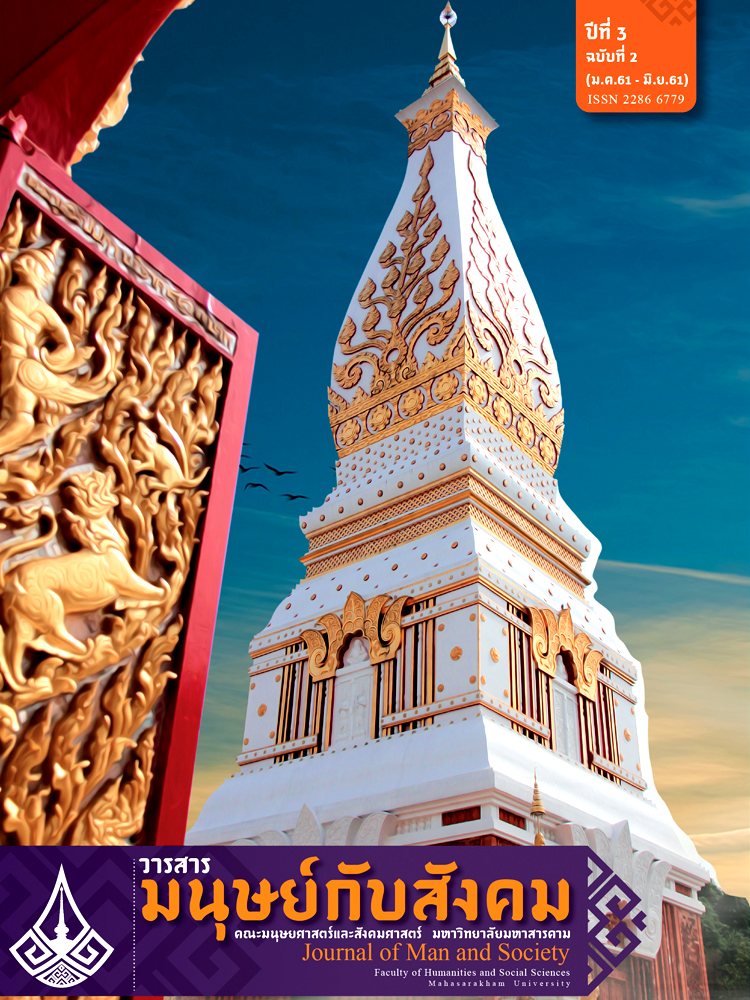Changes of Khmer loanwords appears in Thai dictionary 2493 B.E. and Thai dictionary 2544 B.E
Main Article Content
Abstract
The purpose of this article is to study the form of Khmer loanwords appears in Thai dictionary 2493 B.E. and Thai dictionary 2544 B.E. in term of word changes, semantic changes and word categorization. The findings reveal the fact that 390 words are found in Thai dictionary 2493 B.E. and 499 words are found in Thai dictionary 2554 B.E. The criteria for studying are as follows. The study of word changesare divided into two categories; original words and changed words. The study of semantic changesare divided into four categories; broadening, narrowing, shifting and original meaning. Word categorization can be found in four groups; human nature, human behavior, intelligence emotion mood value and personal relationship.
The study found that in term of word changes, the largest group, 366 words, is the original words and two of changed words are found. In the study of semantic changes, 258 original meaning words are mostly found and 12 of shifting meaning words are found the least. And Word categorization, the largest group is about human and human behavior, 160 words. The smallest group is about intelligence, emotion, mood, value which has 77 words. In addition loanwords from both dictionaries containshared words, lost words and increased words.
Article Details

This work is licensed under a Creative Commons Attribution-NonCommercial-NoDerivatives 4.0 International License.
เนื้อหาและข้อมูลที่ตีพิมพ์ลงในวารสารมนุษย์กับสังคม ถือเป็นข้อคิดเห็นและความรับผิดชอบโดยตรงของผู้เขียนซึ่งกองบรรณาธิการวารสารไม่จำเป็นต้องเห็นด้วยหรือร่วมรับผิดชอบใดๆ
บทความ ข้อมูล เนื้อหา รูปภาพ ฯลฯ ที่ได้รับการตีพิมพ์ในวารสารมนุษย์กับสังคม ถือเป็นลิขสิทธิ์ของวารสาร หากบุคคลหรือหน่วยงานใดต้องการนำทั้งหมดหรือส่วนหนึ่งส่วนใดไปเผยแพร่ต่อต้องอ้างอิงวาสาร
References
กาญจนา นาคสกุล. (2548). พจนานุกรมไทย–เขมร. กรุงเทพฯ: สำนักพิมพ์แห่งจุฬาลงกรณ์มหาวิทยาลัย.
ชูชาติ ชุ่มสนิท. (2559). คำไทยเทียบคำเขมร. พิมพ์ครั้งที่ 2. กรุงเทพฯ: ดอกหญ้าวิชาการ.
ไทรงาม ประมวลศิลป์ชัย. (2532). วัฒนธรรมภาษาของคำยืมที่ปรากฏในพจนานุกรมฉบับราชบัณฑิตยสถาน พ.ศ. 2525. วิทยานิพนธ์ศิลปศาสตรมหาบัณฑิต สาขาภาษาไทย คณะมนุษยศาสตร์และสังคมศาสตร์ มหาวิทยาลัยมหาสารคาม.
นิชรา อัศววิบูลย์. (2533). การเพิ่มคำ การสูญคำและการเปลี่ยนแปลงความหมายของคำกริยา ในช่วง พ.ศ. 2416–2525. วิทยานิพนธ์ปริญญามหาบัณฑิตสาขาภาษาไทย คณะมนุษยศาสตร์และสังคมศาสตร์ มหาวิทยาลัยศรีนครินทรวิโรฒ พิษณุโลก.
บัญญัติ สาลี. (2553). คำยืมภาษาเขมรในภาษาไทย: กรณีศึกษามหาชาติคำหลวง.วิทยานิพนธ์ปริญญาศิลปศาสตรดุษฎีบัณฑิต สาขาภาษาไทย คณะมนุษยศาสตร์และสังคมศาสตร์ มหาวิทยาลัยนเรศวร.
บุญยงค์ เกศเทศ. (2521). เขียนไทย. กาฬสินธุ์: จิตตภัณฑ์การพิมพ์.ราชบัณฑิตยสถาน. (2519). พจนานุกรมฉบับราชบัณฑิตยสถาน พ.ศ. 2493. พิมพ์ครั้งที่12. กรุงเทพฯ: ศาสนภัณฑ์.
. (2556). พจนานุกรมฉบับราชบัณฑิตยสถาน พ.ศ. 2554. พิมพ์ครั้งที่ 2.กรุงเทพฯ: ศิริวัฒนาอินเตอร์พริ้นท์ จำกัด (มหาชน).
Voegelins, C. F. & F. M. (1957). Hopi Domain: A lexical Approach to the Problem ofSection. Supplement to International Journal of American Linguistics,14, Pt.II.


